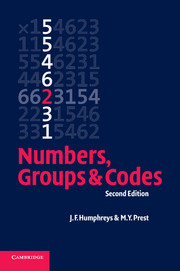Book contents
- Frontmatter
- Contents
- Preface to first edition
- Preface to second edition
- Introduction
- Advice to the reader
- 1 Number theory
- 2 Sets, functions and relations
- 3 Logic and mathematical argument
- 4 Examples of groups
- 5 Group theory and error-correcting codes
- 6 Polynomials
- Appendix on complex numbers
- Answers
- References and further reading
- Biography
- Name index
- Subject index
Preface to second edition
Published online by Cambridge University Press: 05 September 2012
- Frontmatter
- Contents
- Preface to first edition
- Preface to second edition
- Introduction
- Advice to the reader
- 1 Number theory
- 2 Sets, functions and relations
- 3 Logic and mathematical argument
- 4 Examples of groups
- 5 Group theory and error-correcting codes
- 6 Polynomials
- Appendix on complex numbers
- Answers
- References and further reading
- Biography
- Name index
- Subject index
Summary
We have prepared this second edition bearing in mind the fact that students studying mathematics at university, at least in the UK, are less well prepared than in the past. We have taken more time to explain some points and, in particular, we have not assumed that students are comfortable reading formal statements of theorems and making sense of their proofs. Especially in the first chapter, we have added many comments designed to help the reader make sense of theorems and proofs. The more ‘mathematically sophisticated’ reader may, of course, read quickly through these comments. We have also added a few more straightforward exercises at the ends of some sections.
Two major changes in content have been made. In Chapter 3 we have removed material (some propositional logic, Boolean algebras and Karnaugh maps) around Boolean algebras. We have retained most of the material on propositional logic, added a section designed to help students deal with quantifiers and added a further section on proof strategies. The emphasis of this chapter is now on the use of logic within mathematics rather than on the Boolean structure behind propositional logic.
The second major change has been the inclusion of a new chapter, Chapter 6, on the algebra of polynomials. We emphasise the similarity with the arithmetic of integers, including the usefulness of the notion of congruence class, and we show how polynomials are used in constructing cyclic codes.
- Type
- Chapter
- Information
- Numbers, Groups and Codes , pp. xPublisher: Cambridge University PressPrint publication year: 2004

